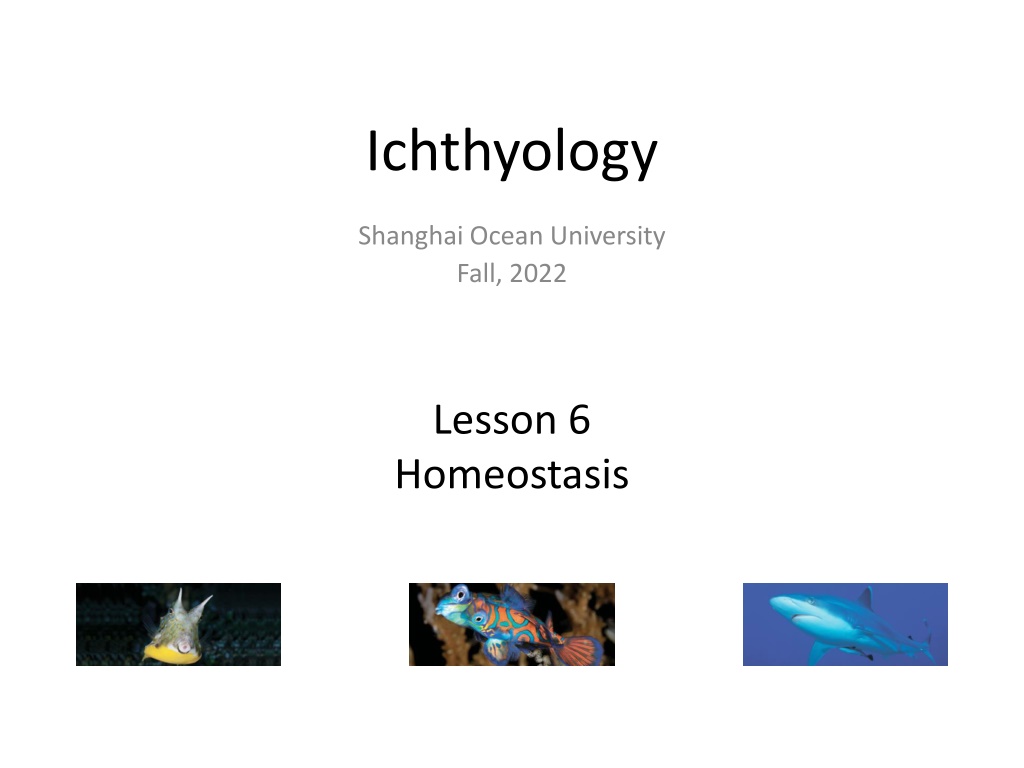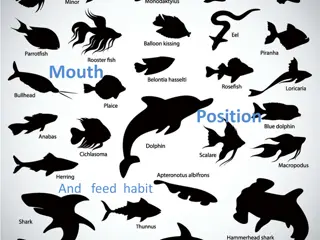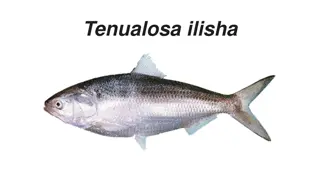Insights into Fish Physiology and Thermal Regulation
Exploring the intricate mechanisms of fish physiology, particularly focusing on the autonomic nervous system's role in controlling internal organ functions and maintaining homeostasis. Additionally, delving into how fishes manage thermal regulation and optimize body temperature for growth, feeding, and physiological functions.
Download Presentation

Please find below an Image/Link to download the presentation.
The content on the website is provided AS IS for your information and personal use only. It may not be sold, licensed, or shared on other websites without obtaining consent from the author. Download presentation by click this link. If you encounter any issues during the download, it is possible that the publisher has removed the file from their server.
E N D
Presentation Transcript
Ichthyology Shanghai Ocean University Fall, 2022 Lesson 6 Homeostasis
The autonomic nervous system Involuntary physiological functions, such as control of internal organ function, are at least in part controlled by the autonomic nervous system or ANS Neural signals from the central nervous system (brain and spinal cord) travel to ganglia of the ANS that are located either along the spinal cord or near or within the target organs. Signals then travel from these ganglia to the target tissues. The ANS often works together with the endocrine system to control involuntary physiological functions such as heart rate, blood pressure, blood flow through the gills, and many functions of the gastrointestinal system that are important to digestion and nutrition.
The autonomic nervous system The ANS also controls gas bladder volume, and therefore fish buoyancy, by regulating the absorption and secretion of gases and blood flow to various parts of the gas bladder The dispersion and aggregation of pigment in melanophores is also partly controlled by the ANS, along with melanophore-stimulating hormone from the anterior pituitary
Temperature relationships Most fishes are ectothermic because they lack any mechanism for heat production and retention. In addition, when blood flows through the gills it becomes the same temperature as the surrounding water due to the thin gill membranes interesting exceptions of heat production or conservation in some fishes, a condition often referred to as either heterothermy or regional endothermy
Thermal Regulation Can fish maintain body temperature? Yes, to a certain degree. Both physiological and behavioral mechanisms exist. Why regulate body temperature?
Thermal Regulation Why regulate body temperature? Answer = optimum growth, feeding, physiological function, etc. Too low Too high Optimum Temperature
Thermoregulation by tunas Large Swimming Muscles Equipped with blood vessels that function as countercurrent heat-exchangers. Keep body temperature above that of surrounding water.
Thermoregulation or ocular muscles that have become modified into heater organs . In all cases the heat is retained by a rete a modification of the circulatory system that forms a countercurrent exchange mechanism. In Swordfish (Xiphiidae) and marlins (Istiophoridae) the superior rectus eye muscle, and in the Butterfly Mackerel (Scombridae) the lateral rectus eye muscle, have lost the ability to contract and instead produce heat when stimulated by the nervous system.
Temperature adaptation Many physiological adjustments are the result of switching on or off genes that are responsible for the manufacture of particular proteins. For example, acute heat stress initiates the synthesis of stress proteins, also known as heat shock proteins or HSPs, which maintain the structural integrity of proteins that otherwise would become denatured at higher temperatures, thereby allowing them to function biochemically
Temperature adaptation To compensate for the decreased rate of biochemical reactions at low temperatures, fishes may increase the concentration of intracellular enzymes by altering the rate of enzyme synthesis, degradation, or both. Increased cytochrome c concentration in Green Sunfish (Centrarchidae) that were moved from 25 to 5 C is due to a greater reduction in the degradation rate than in the rate of synthesis
Temperature adaptation In some fishes alternative enzymes (termed isozymes) may be produced to catalyze the same reaction more efficiently at different temperatures. Isozymes are regulated by switching on or off the different genes that control their production. Rainbow Trout (Salmonidae) acclimated to 2 versus 18 C exhibit different forms of acetylcholinesterase, an enzyme important to proper nerve function because it breaks down the neurotransmitter acetylcholine
Temperature relationships Mummichog (Cyprinodontidae) along the east coast of the United States exhibit two allozymes of lactate dehydrogenase, an important enzyme in carbohydrate metabolism. In Maine, the frequency of the allele for the form more effective at colder temperatures is nearly 100%, and the frequency decreases progressively in populations further to the south (Place & Powers 1979). In Florida, the alternative allele, which codes for the form more effective at higher temperatures, has a frequency approaching 100%.
High temperature may cause structural degradation (denaturation), resulting in partial or complete loss of function. Decreased oxygen availability due to limited gas solubility. When combined with elevated oxygen demand due to increased metabolic rate and a temperature-induced Bohr effect that interferes with hemoglobin function
low temperature Probably the greatest potential danger at very low temperatures is intracellular formation of ice crystals which can puncture cell membranes and organelles, leading to cell death. Glycoproteins, can bring the freezing point of some Antarctic fishes, well below the freezing point, function by adhering to small ice crystals as they begin to form preventing growth of the seed crystal. Rainbow Smelt produce glycerol to increase the osmotic concentration of the blood and intracellular fluids, thereby further decreasing the freezing point
Osmoregulation One of the most important homeostatic functions of living organisms is proper regulation of the internal osmotic environment. Deviation from the normal range can jeopardize proper physiological function through water loss or gain Fishes that can tolerate only small changes in the solute concentration of their external environment are referred to as stenohaline, whereas those with the ability to osmoregulate over a wide range of environmental salinities are euryhaline.
Osmoregulation in different types of fishes Explain osmoregulation in elasmobranchs, freshwater and marine teleosts.
Osmoregulation maintaining internal salt/water balance Again, optimum functionality! Why is it such a challenge? Osmosis free movement of water from high to low concentrations.
Strategies for ionic regulation 1. Osmoconformers same natural internal salt concentration as seawater 2. Osmoregulators regulate internal salt concentration a. Isosmotic actively maintain same concentration as seawater Elasmobranchs sharks, skates, and rays
Strategies for ionic regulation 2. Osmoregulators regulate internal salt concentration b. Hyposmotic actively maintain lower salt concentration than surrounding water Most marine bony fishes maintain approximate 1/3 concentration of seawater How? -Drink large amounts -Pump sodium and chloride ions out via gills and magnesium and sulfate ions out via kidneys
Strategies for ionic regulation 2. Osmoregulators regulate internal salt concentration b. Hyperosmotic actively maintain higher salt concentration than surrounding water Freshwater teleosts (basically all ray-finned, bony fishes except sturgeons, bowfins, and gars) How? -Constantly take on water produce a lot of urine -Do lose salts via urine, but are able to maintain higher concentration than surrounding water























